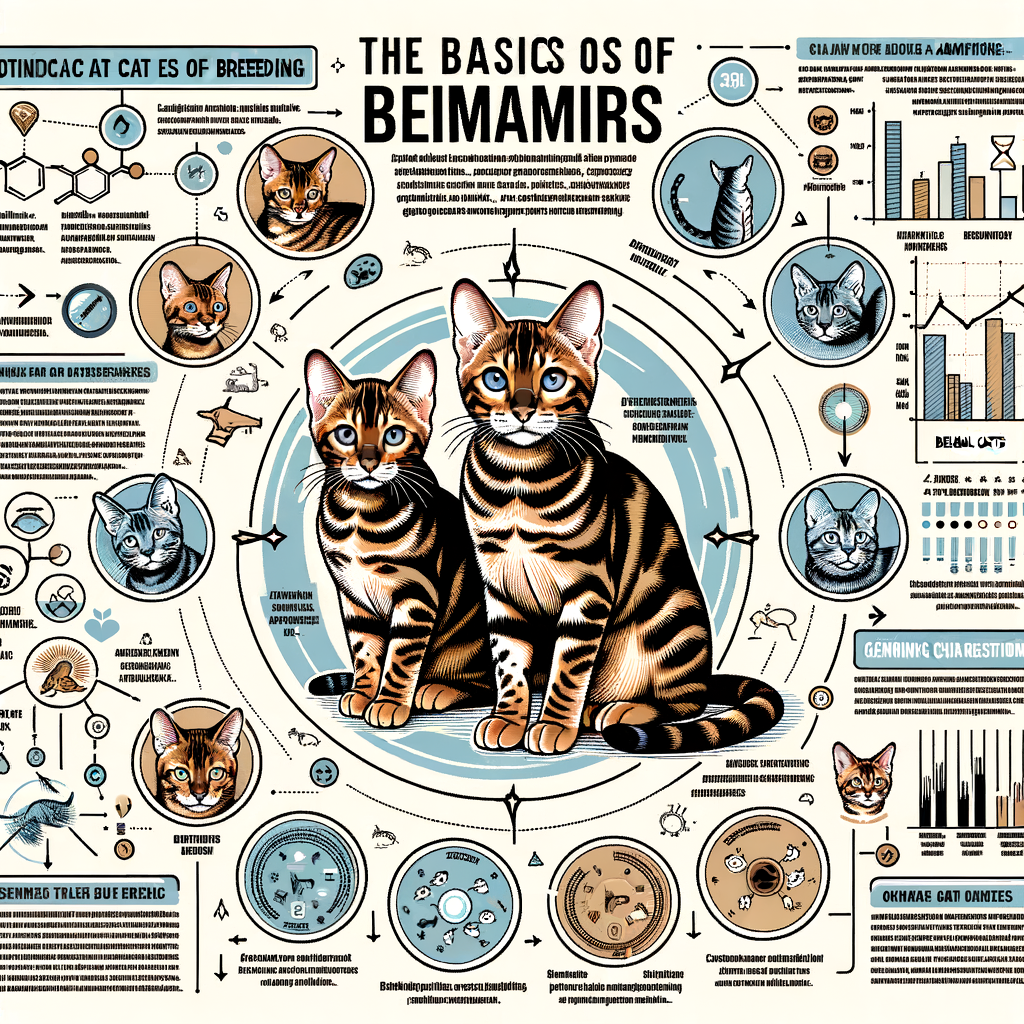
Introduction to Bengal Cat Breeding
Welcome to the fascinating world of Bengal cat breeding. This guide will help you understand the ins and outs of breeding these exotic and beautiful creatures. We will delve into why people choose to breed Bengal cats and the knowledge required to do it successfully.
- Understanding Bengal Cat Breeding
- Why breed Bengal cats?
- Bengal Cat Breeding Knowledge
Breeding Bengal cats is not just about producing kittens. It’s about understanding the breed’s unique characteristics, health issues, and temperament. Bengal cats are known for their striking coat patterns, playful nature, and high energy levels. Breeding them requires a deep understanding of their needs and traits.
People breed Bengal cats for various reasons. Some are attracted to their exotic appearance, which resembles that of a wild leopard. Others appreciate their playful and energetic nature. Breeding Bengal cats can also be a rewarding experience, as it contributes to the preservation of this unique breed. However, it’s important to remember that breeding should always be done responsibly, with the welfare of the cats as the top priority.
Breeding Bengal cats requires a significant amount of knowledge and preparation. Breeders need to understand the breed’s genetic traits, potential health issues, and breeding cycles. They also need to be prepared for the responsibility of caring for the mother cat during pregnancy and the kittens after birth. Breeding is not a task to be taken lightly, but with the right knowledge and commitment, it can be a rewarding experience.
In the following sections, we will delve deeper into the basics of Bengal cats and breeding. We will also share some expert tips on mastering Bengal cat breeding. So, whether you’re a seasoned breeder or a curious cat lover, stay tuned for more insightful information.
Bengal Cat Basics
Let’s dive into the fascinating world of Bengal cats. These cats are known for their striking appearance and playful behavior. But there’s more to them than meets the eye. Let’s explore their characteristics.
Characteristics of Bengal Cats
Bengal cats are unique in many ways. They have distinct physical and behavioral traits that set them apart from other cat breeds. Here’s what you need to know:
-
Physical Traits
Bengal cats are medium to large-sized cats. They usually weigh between 8 to 15 pounds. Their bodies are muscular and athletic, built for agility and strength. The most noticeable trait of a Bengal cat is its beautiful coat. It’s short, dense, and comes in a variety of colors and patterns. The most common are the spotted or marbled patterns, which give them a wild, leopard-like appearance. Their eyes can be green, gold, or blue, and they have a strong, square jawline.
Physical Trait Description Size Medium to large Weight 8 to 15 pounds Coat Short, dense, spotted or marbled Eye Color Green, gold, or blue Jawline Strong, square -
Behavioral Traits
Bengal cats are known for their high energy levels and playful nature. They are intelligent and curious, always eager to explore their surroundings. They enjoy playing games and can even be trained to perform tricks. Bengal cats are also very social. They enjoy the company of their human family and can get along well with other pets. However, they can be a bit territorial and may not like sharing their space with other cats.
Behavioral Trait Description Energy Level High Intelligence High Social Behavior Sociable, can get along with other pets Territorial Yes
Understanding these characteristics can help you provide the best care for your Bengal cat. Remember, every cat is unique, and your Bengal may not exhibit all these traits. The most important thing is to love and care for your pet, no matter what.
Understanding Bengal Cat Health
When it comes to Bengal cats, it’s important to understand their health needs. Just like any other pet, Bengals can face certain health issues. However, with the right preventive care, you can ensure your Bengal cat lives a long, healthy life. Let’s delve into the details.
- Common Health Issues
- Progressive Retinal Atrophy (PRA): This is a genetic condition that can lead to blindness. It’s important to get your Bengal cat’s eyes checked regularly.
- Hypertrophic Cardiomyopathy (HCM): This is a heart disease that can affect Bengal cats. Regular vet check-ups can help detect this condition early.
- Pyruvate Kinase Deficiency (PK Deficiency): This is a metabolic disorder that can cause anemia. It’s a genetic condition, so if your Bengal cat’s parents were carriers, your cat might be at risk.
- Preventive Care
- Regular Vet Visits: Regular check-ups can help detect any health issues early. Your vet can also provide vaccinations and other preventive treatments.
- Proper Nutrition: A balanced diet is crucial for your Bengal cat’s health. Make sure your cat gets the right nutrients.
- Exercise: Bengal cats are active and need plenty of exercise. Regular playtime can help keep your cat healthy and happy.
Bengal cats are generally healthy, but they can be prone to certain health problems. Here are a few common ones:
Preventive care is key to keeping your Bengal cat healthy. Here’s what you can do:
Remember, every Bengal cat is unique and may have different health needs. Always consult with your vet for the best care for your pet.
Breeding Basics
Let’s delve into the fascinating world of cat breeding, focusing on the unique aspects of Bengal cats. This section will provide you with a fundamental understanding of cat breeding and the specifics of breeding Bengal cats.
Understanding Cat Breeding
Cat breeding is a complex process that requires knowledge, patience, and a love for cats. It’s not just about pairing two cats together; it’s about understanding their genetics, health, and behavior.
- General Cat Breeding Information
- Specifics of Breeding Bengal Cats
Every cat breed has unique characteristics and traits. When breeding cats, it’s essential to understand these traits to ensure the kittens’ health and well-being. Breeding involves selecting parent cats that are healthy, have good temperaments, and exhibit the desired traits of their breed.
Bengal cats are a unique breed with distinct traits. They are known for their striking coat patterns that resemble those of a wild leopard. Breeding Bengal cats requires a deep understanding of their genetics to maintain their unique coat patterns and ensure their health. Bengal cats are generally healthy, but they can be prone to certain genetic health conditions. Therefore, it’s crucial to screen potential parent cats for these conditions before breeding.
Understanding the basics of cat breeding, especially for a unique breed like the Bengal, is the first step towards becoming a successful cat breeder. It requires dedication and a commitment to the health and well-being of the cats. In the next section, we will discuss how to prepare for breeding.
Preparing for Breeding
Before you embark on the journey of Bengal cat breeding, there are a couple of crucial steps you need to take. These steps are essential in ensuring the health and wellbeing of both the mother and the kittens. Let’s take a closer look at these steps.
- Choosing suitable cats for breeding
- Health checks and vaccinations
Not all cats are suitable for breeding. When selecting Bengal cats for breeding, there are several factors to consider. Firstly, the cats should be of optimal breeding age. For females, this is usually between 18 months and 7 years, while males can breed from 18 months to 10 years. Secondly, the cats should be healthy, with no signs of illness or genetic disorders. Lastly, the cats should have a good temperament. Bengal cats are known for their playful, affectionate nature, and these traits should be evident in the cats you choose for breeding.
Health checks and vaccinations are a vital part of preparing for breeding. Before breeding, both cats should undergo a thorough health check by a vet. This will ensure they are free from any health issues that could affect the pregnancy or the kittens. Vaccinations are also crucial. They protect the mother and kittens from various diseases. Ensure that both cats are up-to-date with their vaccinations before breeding. Remember, a healthy cat equals healthy kittens.
In conclusion, preparing for breeding is a critical step in the Bengal cat breeding process. By choosing suitable cats for breeding and ensuring they are healthy and vaccinated, you can increase the chances of a successful breeding and healthy kittens.
Mastering Bengal Cat Breeding
For those who are passionate about Bengal cats and wish to breed them, there are several key factors to consider. Breeding these beautiful and exotic cats requires a deep understanding of their needs, behaviors, and health considerations. Let’s delve into some crucial tips to help you master the art of Bengal cat breeding.
Bengal Cat Breeding Tips
Here are some essential tips to keep in mind when breeding Bengal cats:
- Creating a comfortable environment: Bengal cats, like any other animal, require a safe and comfortable environment for breeding. This means providing them with a quiet, clean, and spacious area where they can relax and feel secure. It’s also important to ensure that the area is free from loud noises and other pets that may cause stress. A comfortable environment will help the cats feel at ease and increase the chances of successful breeding.
- Monitoring the breeding process: Breeding Bengal cats require careful monitoring. This includes keeping an eye on the cats’ behavior, ensuring they are eating well, and checking for any signs of discomfort or illness. It’s also crucial to monitor the female cat’s heat cycle and to introduce the male and female at the right time. Remember, patience is key in the breeding process. It may take several attempts before the cats successfully mate.
Mastering Bengal cat breeding requires time, patience, and a deep understanding of these unique cats. By creating a comfortable environment and closely monitoring the breeding process, you can increase your chances of success and contribute to the preservation of this beautiful breed.
Post-Breeding Care
- Caring for the Mother Cat
After the breeding process, the mother cat, also known as the queen, needs special care. It is crucial to provide her with a nutritious diet to help her regain her strength. Regular vet check-ups are also essential to ensure her health and well-being.
- Caring for the Kittens
Once the kittens are born, they require a warm and safe environment. They should be fed with a high-quality kitten formula until they are ready for solid food. Regular vet visits are also important for their growth and development.
- Case Study 1
Consider the case of Bella, a Bengal queen who gave birth to five kittens. After delivery, Bella was provided with a high-protein diet and regular vet check-ups. Her kittens were kept in a warm environment and fed with a premium kitten formula. As a result, Bella regained her strength quickly and her kittens grew healthily.
- Case Study 2
Another example is Max, a Bengal kitten from Bella’s litter. Max was the smallest of the litter, but with proper care and nutrition, he grew into a healthy and active Bengal cat. This case demonstrates the importance of post-breeding care for both the mother cat and the kittens.
- Recap of Bengal Cat Breeding Information
In summary, Bengal cat breeding involves understanding the basics of Bengal cats, creating a comfortable environment for breeding, monitoring the breeding process, and providing post-breeding care. The latter includes caring for the mother cat and the kittens, as illustrated in the case studies of Bella and Max.
- Final Thoughts on Breeding Bengal Cats
Breeding Bengal cats can be a rewarding experience if done correctly. It requires dedication, patience, and a deep understanding of the breed. Remember, the health and well-being of the cats should always be the priority. Happy breeding!






